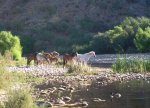Step Two: Abdominal breathing.
The next step in the process of Issho-ibuki is to efficiently fill your lungs with air. To achieve efficiency, you need to inhale and exhale through the lower abdomen. The following exercise was developed by me for use in the Issho Dojo to facilitate this type of deep abdominal breathing. Lie on your back and relax. While lying on your back, rest your hands, palms down, on your lower abdomen, referred to as your “belly“. This placement of the hands does not facilitate breathing, rather, your hands will provide an added sensory indication of the proper breathing method through the sense of touch.
Open your mouth, as previously described, relax your belly and allow the natural force of gravity to decompress your belly, thus expelling air through your mouth. Keep your hands in contact with your belly and allow your hands to lower with your belly. Now, close your mouth, pressing your tongue on its roof and inhale through the nose. As you inhale, willfully direct the air to the lower belly so as to force it to expand and rise upwards. Keep your hands in contact with your belly and allow your hands to rise with your belly. You will again exhale by opening your mouth, pressing your tongue downward, relaxing and decompressing your belly so as to exhale. Allow your hands to lower and decompress with your belly. The duration of exhalation should be slightly longer than the inhalation. Both processes should be completely relaxed. Continue to breathe in this manner for a period of about five minutes. You should immediately begin to incorporate abdominal breathing into not only fly-fishing but all your activities.
Step Three: The Manner Of Breathing.
The next phase in the Issho-ibuki is to perform the act of inhalation and exhalation in a specific manner. In Goshin-Do Karate-Do we referred to the manner of breathing as either “Go“ or “Hard” and “Ju” or “Soft“. It is important to remember that the METHOD of breathing remains the same as described above. Only the MANNER of breathing is altered as follows. For purposes of this article, only the soft manner of breathing is relevant. Soft breath is a relaxed form of breathing. The body remains relaxed as air is gently inhaled in a steady manner. Once inhalation is complete, the breath is held for a fraction of a second and exhalation begins. During the process of exhalation, the body remains relaxed and air is expelled softy and in a steady manner. The process then begins a new.
You can and should incorporate soft Issho-ibuki into all aspects of your fly-fishing. Use Issho-ibuki to steady yourself during the hike to your favorite water or while wading a stream or salt water flat. You can use Issho-ibuki to calm yourself as you cast to rising, but wary fish. You can effectively increase the performance and technique of fly casting by using Issho-ibuki during the casting process. You must remember that you always want to exhale during your power casting for stroke. You will soon see that the mechanics and enjoyment of fly fishing greatly increase when you finally learn to breath properly. Proper breathing is the first step to Fly-fishing like a Karate Master and enriching you fly-fishing performance and enjoyment.
NOW AVAILABLE – The Sanchin Kata Video Series – follow this weblog for free links to videos.
Here is a link to a promotional video with information on how you can purchase your 57 minute Sanchin DVD: http://www.youtube.com/watch?v=J-pC-tPUrYE
See my website WWW.Dynamic-Meditation.Com or blog WWW.SenseiJohn.Wordpress.Com for information on how to purchase the video series. You may also e-mail me directly.
If you are intrigued by this article or otherwise enjoy this blog, please remember to tell a friend. Check back weekly for more updates on how to fly fish like a Karate master, articles on the Way of Fly-fishing (Fly-fishing Do), fishing reports, product reviews and other fly-fishing related matters.
ENDNOTES:
1. The Kanji, Japanese writing, for Sanchin translates as three battles. Fundamental to understanding the three battles of Sanchin is proper breathing. If you would like to learn more about either proper breathing or Sanchin Kata, please feel free to visit my martial arts blog WWW.SenseiJohn.Wordpress.Com and website WWW.Dynamic-Meditation.Com.
Please feel free to shop unique Fly-Fishing Dojo logo products. To do so, click on the “SHOP” tab at the top of this page.




























